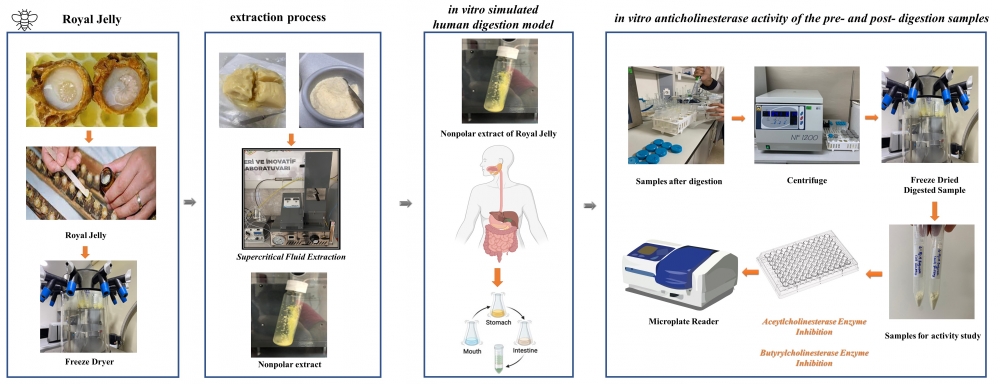JOURNAL 3147
Records of Agricultural and Food Chemistry
Year: 2024 Issue: 3 Special Issue: Abstracts 3rd. TCS, International Food Chemistry Congress February 29-March 03,2024 Antalya Türkiye
p.51 - 51
Viewed 694 times.
GRAPHICAL ABSTRACT

ABSTRACT
Human beings have never given up on natural products despite the modern medicines that have emerged with the developing technology. On the contrary, with the development of technology, natural products have been examined and the active compounds in their content have succeeded in obtaining better quality natural products and even developed complementary treatment methods. Apitherapy, defined in the Regulation on Traditional and Complementary Medicine published by the Ministry of Health in 2014, involves the complementary and supportive use of bee and bee products in the treatment of diseases. Bee products, including honey, pollen, propolis, royal jelly, bee venom, and beeswax are well-known. Royal jelly is particularly favored due to its rich content. Royal jelly, one of the most valuable bee products, is a viscous nutrient similar to milk produced by worker bees (Apis mellifera L.) to feed queen bees [1]. Royal jelly is an important functional nutrient widely used in commercial products, such as cosmetics and dietary supplements [2]. For this reason, the effectiveness of royal jelly, which is widely used both directly and in mixture with bee products such as honey and pollen, in the digestive process, has been a subject of curiosity and in vivo studies have been reported in this field. It has been reported that royal jelly reduces the activation of substances that reduce cognitive activity in animals given royal jelly [3]. Although there are bioaccessibility studies on many natural products, there are no sufficient studies on in vitro gastrointestinal digestion models of bee products. Bioaccessibility consists of stages, such as digestion of active metabolites in the GI system, absorption, metabolism, distribution to tissues and physiological response. In this study, the anticholinesterase activities of royal jelly extracts before and after in vitro digestion were investigated. Two different extracts rich in polar and apolar compounds were obtained from lyophilized royal jelly by supercritical fluid extraction. The pre- and post- digestion anticholinesterase activities of the apolar extract digested by in vitro human digestion model were determined by spectrophotometric methods using AChE and BChE enzymes.
KEYWORDS- Royal jelly
- anticholinesterase
- 10-HDA
- simulated digestion